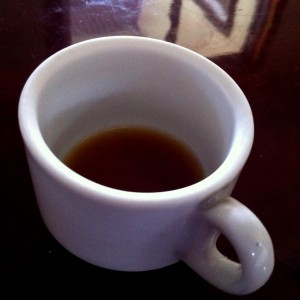An absolute favourite of our mornings.
I enjoy it medium roasted, double espresso with a splash of (soya) milk. Particularly, as a breakfast hot drink, I like it with a couple of pieces of toasts or (as we don’t usually eat bread) with a couple of almond flour pancakes. John necks down two mugs of very milky coffee. He likes the milk especially hot. He doesn’t eat breakfast so the two mugs of coffee is his fuel for the morning till lunchtime.
In northern Panama I had a chance to visit a coffee company to take a 3 hours tour on the plantation, then visit the factory and learn about coffee. This family company was particularly fussy about their coffee and plant it, grow it, harvest it, handle it with great care. There are something like 12 steps in coffee producing business from planting to drinking which I don’t remember all but I remember the important part which is the roasting.
There are 4 roasts:
1 Light roast: Light brown in colour. This roast is generally preferred for milder coffee varieties. There will be no oil on the surface of these beans, because they are not roasted long enough for the oils to break through to the surface
2 Medium roast: Medium brown in colour with a stronger flavour, and a non-oily surface.
3 Medium-Dark roast: Dark Rich, dark colour with some oil on the surface and with a slight bittersweet aftertaste
4 Extra Dark roast: Shiny black beans with a oily surface and a pronounced bitterness. The darker the roast, the less acidity will be found in the coffee drink.
What they told me is that the darker the coffee (Italian, Latino) the more bitter the taste though the weaker its strength. Heat takes away caffeine. The difference between perfectly roasted coffee and a ruined batch can be a matter of seconds. It takes years of training to be an expert roaster and requires high level of tech skills. Ha! I love this.
Apparently cooking also gets rid of caffeine. I.e. officially Italian espresso is made with 110C water/steam and traditionally is made with medium/dark roast so practically not much caffeine left in the output. Probably that’s why Italians can drink espresso after dinner. Which sounds marvellous to me.
On the other hand back in England people love making coffee with that plunge thingy. Usually it is the European roast that available so when they pour the relatively hot water over 3-4 spoons of coffee and leave it soak for 5 or more minutes that equals with a great painful horse kick. Definitely a receipt for a 2 day migraine for me.
Learning this gave me a good idea of making really good coffee with our favourite coffee maker. Ironically, there is only one problem with that here in South America; there is only the Extra Dark roast is available -so far in Colombia, Venezuela, Brazil, Peru and Ecuador. It is burnt to death and is awful. Back a few months ago, Central American countries had the choice and we always found medium roast. Our favourite coffee in taste and value was found in Honduras, a local made, no-big-fuss packaging (can’t remember the name), light or medium roast, smooth taste, old-gold colour coffee. That was very nice. If I had a coffee grinder I’d made my own roast. (well, in after a few years of practising apparently)
Advice for those travelling from North to South; if you find coffee you like in Central America, stock up and hold on to it. If you are travelling the other way round; Hang on, there will be tasty coffee on the other side!
That’s all I can say about coffee.




Do you guys have a picture of the coffee from Honduras or was it just a random bag with no brand?
We don’t. It was just a random local brand.